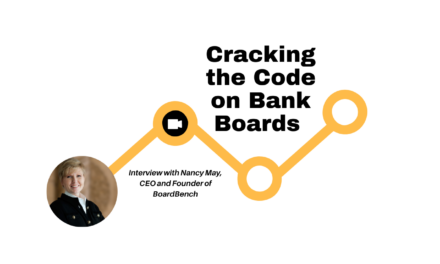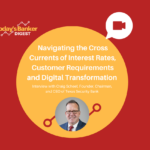One of the most important things you can learn as a leader is how to bring out the best in others. Not only will you empower people to have a successful career, you will also positively impact their everyday life.
Organizational health calls for hiring for the right fit. This starts with a careful selection of people to lead your teams. Let’s face it, managing people is not for everyone, yet it plays such an important role in creating the culture you want for your teams. Leaders hold the keys to employees becoming engaged and help live out the mission and core values of your organization. Bankers are very aware leadership cannot be taken lightly. The wrong person in a leadership role can have a lasting, negative impact on your entire organization and lead to a higher turnover and an increase in disengaged team members.
A friend recently offered me a bit of unsolicited advice when I had to make a tough call on a situation at school for our daughter. I was worried about what other parents would think about my decision when a mom I shared my conflict with told me: “Good for you! You are the parent and parenting is not for the weak!” Without her encouragement I may not have stayed true to my conviction.
Leading, supervising and managing others is not for the weak either. When a leader isn’t trained and coached to stay on course when faced with tough choices, they will often stall or ignore what needs to be addressed. Acting on and handling tricky situations is a part of a supervisor’s job. If they are unprepared, lingering tough stuff may be the weakest link in the supervisor’s performance.
Managing and leading a team can be one of the most rewarding experiences you will ever go through in your career, but it is a road full of twists and turns. Often considered the most stressful part of leading is dealing with personality conflicts or poor performance. Sticky situations become defining moments for any leader (new or seasoned) so the bank must invest in equipping their leaders to handle this tough stuff.
Hiring and promoting the right candidates in leadership roles is only the start. We need to surround our leaders with the right coaches and mentors. We also need to support them with training and development to pave the road for success.
When we launch a new software system or new Asset/Liability model, our first priority is to provide training to ensure everyone learns how to navigate and operate our new system. The training is the insurance policy that ensures the investment will be protected against mistakes and failure. Why wouldn’t we look at leading and managing in the same way? What if we promote someone to a supervisor or management position and we don’t give them the tools they need to succeed at becoming a successful leader?
When you were made a leader, you weren’t given a crown, you were given the responsibility to bring out the best in others. Jack Welch – former CEO of GE
Here are a few best practices to get you started and develop your managers and supervisors into great teambuilders within your bank:
Hire the RIGHT people and TRAIN THEM WELL
Learning the skills and experiencing the world of leading and managing is a process not a one-and-done training session. Seek out opportunities to attend training on leadership topics. There is power in attending training where you can engage with others in the same role, especially in relating to and handling the tough stuff.
Set the EXPECTATION – Developing people is NOT AN OPTIONAL TASK
You have a significant responsibility to help each of your team members maximize their potential. Developing our people is the single most important activity that we are accountable for as managers. Powerful, right? It should be! We need to turn our focus from our own personal aspirations to growing our people. There’s no cookie cutter solution. The approach will look vastly different for each individual team member. Successful leaders understand this.
Consider yourself the COACH or MENTOR instead of the BOSS!
Don’t put yourself on a pedestal. Those who do fail to understand that the view from anywhere else but that seat is not very attractive. Coaches and mentors are much more successful in developing their people. The difference between a coach and a boss is that the coach comes across as being humble, encouraging, and REAL. It’s easy to see which one would be the most effective leader!
Identify your Directors of Fun and ENGAGE your employees.
Successful leaders know who the Directors of Fun are within the workplace. It’s the little daily things that can make or break a culture that fuels and engages the team. Identify who can take this to the next level in your bank. The budget doesn’t have to be big but the benefits and rewards will be.
The average worker spends most of their waking hours at work rather than at home – do you want a culture that fuels you or sucks the life out of you?
Hiring Practices – The interview!
The interview is the place where our candidates always have on their Sunday best so how do we really identify who are the best fit for our teams? Have we trained our managers and supervisors how to hire for the right fit? Asking the right questions is only part of the equation – the key is knowing what to listen for when the candidates respond with their answers. Reading between the lines can tell us a how big of a team player this person will be and much more.
The Onboarding Experience
We spend a lot of time and money to trying to create the best customer experience as possible, right? Have we examined our onboarding process with the same passion? Instead of focusing on how to do exit interviews (which is still important), have we thought to do a “60 days on the job” interview? Look at your onboarding process and how you can enhance your company’s first impression or the experience of working in your organization. Be open to constructive feedback and most importantly – follow-up!
Get Your Hands in the Clay
Leaders must model the attitude, the work ethic, and the standards they want to see in others. You have the opportunity and obligation to show people how to lead. What others see in a leader is more impactful than what they hear the leader say. Modeling compassion, empathy and caring is the convincing evidence followers need from a leader to commit to the culture of the bank.
Successful leaders know on-going training is crucial to effective leadership. Managing different generations brings its own set of challenges but when we focus on the individual strengths and the unique skills people bring to our teams, we begin to break down traditional generational biases.
Bringing out the best in others is a win all around. It will free up time for the important things, and it creates devoted staff, raving fans, and future leaders.
Whether you are new to leading and managing or have been in your role for some time, attending this year’s Bank Supervisor School will energize you with enthusiasm and practical, empowering strategies. You will find the answers and solutions on what to do, how to do it and what not to do. You will learn techniques that reduce the stress associated with handling conflict and performance reviews. Bank Supervisor School is filled with best practices for all facets of leading and managing people. Managing people is not for the weak. Come and surround yourself with your peers. Share experiences and learn strategies that will help you become a master at supervising others.












